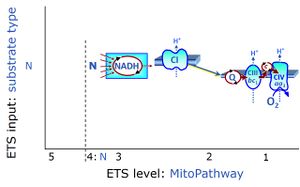Difference between revisions of "NADH electron transfer-pathway state"
m (moved N-linked substrate state to N-pathway control) |
|||
| Line 1: | Line 1: | ||
{{MitoPedia | {{MitoPedia | ||
|abbr=N | |abbr=N | ||
|description=[[File:SUIT- | |description=[[File:SUIT-catg N.jpg|right|300px|N-junction]] | ||
[[NADH]]-linked substrates (CI-linked) are [[ETS substrate types |type N substrates]] of ETS-level 4, feeding electrons into the [[N-junction]] catalyzed by various mt-dehydrogenases. N-supported flux is induced in mt-preparations by addition of NADH-generating substrates individually or in combination: [[pyruvate]], [[glutamate]], [[malate]], [[oxoglutarate]], [[citrate]], [[hydroxybutyrate]]. These type N substrates are (indirectly) linked to [[Complex I]] by the corresponding dehydrogenase-catalyzed reactions reducing NAD<sup>+</sup> to NADH+H<sup>+</sup>. In mt-preparations, succinate dehydrogenase (SDH; [[CII]]) is largely substrate-limited in N-linked respiration, due to metabolite depletion into the incubation medium. The residual involvement of S-linked respiration in the pesence of type N substrates can be further suppressed by the CII-inhibitor [[malonic acid]]). | [[NADH]]-linked substrates (CI-linked) are [[ETS substrate types |type N substrates]] of ETS-level 4, feeding electrons into the [[N-junction]] catalyzed by various mt-dehydrogenases. N-supported flux is induced in mt-preparations by addition of NADH-generating substrates individually or in combination: [[pyruvate]], [[glutamate]], [[malate]], [[oxoglutarate]], [[citrate]], [[hydroxybutyrate]]. These type N substrates are (indirectly) linked to [[Complex I]] by the corresponding dehydrogenase-catalyzed reactions reducing NAD<sup>+</sup> to NADH+H<sup>+</sup>. In mt-preparations, succinate dehydrogenase (SDH; [[CII]]) is largely substrate-limited in N-linked respiration, due to metabolite depletion into the incubation medium. The residual involvement of S-linked respiration in the pesence of type N substrates can be further suppressed by the CII-inhibitor [[malonic acid]]). | ||
|info=[[N-junction]] | |info=[[N-junction]] | ||
| Line 8: | Line 8: | ||
|mitopedia concept=Respiratory state, SUIT state | |mitopedia concept=Respiratory state, SUIT state | ||
}} | }} | ||
= List of publications: N-linked or CI-linked substrate state = | = List of publications: N-linked or CI-linked substrate state = | ||
{{#ask:[[Category:Publications]] [[Substrate states::CI]] | {{#ask:[[Category:Publications]] [[Substrate states::CI]] | ||
Revision as of 02:15, 5 September 2016
- high-resolution terminology - matching measurements at high-resolution
NADH electron transfer-pathway state
Description
NADH-linked substrates (CI-linked) are type N substrates of ETS-level 4, feeding electrons into the N-junction catalyzed by various mt-dehydrogenases. N-supported flux is induced in mt-preparations by addition of NADH-generating substrates individually or in combination: pyruvate, glutamate, malate, oxoglutarate, citrate, hydroxybutyrate. These type N substrates are (indirectly) linked to Complex I by the corresponding dehydrogenase-catalyzed reactions reducing NAD+ to NADH+H+. In mt-preparations, succinate dehydrogenase (SDH; CII) is largely substrate-limited in N-linked respiration, due to metabolite depletion into the incubation medium. The residual involvement of S-linked respiration in the pesence of type N substrates can be further suppressed by the CII-inhibitor malonic acid).
Abbreviation: N
Reference: N-junction
MitoPedia concepts:
Respiratory state,
SUIT state

